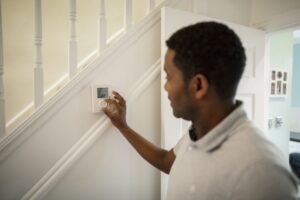6 Ways to Improve a Home’s Indoor Air Quality in Peachtree City, GA
Outdoor air quality is a concern for millions of people, but not many of them realize that indoor air pollution is a concern also. The Environmental Protection Agency, or EPA, has found that exposure to indoor pollutants is often two to five times higher than outdoor levels. Below are six ways to improve a home’s air quality in Peachtree City, GA.
1. Use Air Purifiers, Not Air Fresheners
Air purifiers are an excellent way to combat poor indoor air quality, whether they are placed in the kitchen or bedroom. For natural air purifiers, indoor plants such as chrysanthemums, spider plants and other plants help clean the air.
Air fresheners have many harmful chemicals known to aggravate asthma, allergies and other respiratory issues. ScienceDirect states that they’re also associated with endocrine disruption, cancer and neurotoxicity.
Another way to purify the air in your home is to have an inline air purifier installed in your HVAC system. Inline air purifiers offer cleaner air distribution and produce less noise. One advantage of an inline air purifier in your HVAC system is that all the circulated air is cleaned, not just some of it.
2. Change Filters
Indoor air quality refers to the quality of the air within buildings. Issues with poor air quality include impaired learning, reduced productivity, health issues and sick building syndrome. There are many things in the home that would cause indoor air pollution that a filter and an air purifier would collect. These include:
- Cigarette smoke
- Air fresheners
- Household cleaners
- Carbon monoxide
- Microbes
- Asbestos
You should regularly replace the air filters in your cooling system and air purifier. When an air filter becomes clogged or dirty, it doesn’t filter effectively, allowing more pollutants to enter the home.
3. Eliminate Microbes
Once spores come in, they circulate around and outside the home until they find a perfect spot to grow. That perfect spot isn’t always in plain sight. Symptoms of sickness caused by microbes include itchy, watery eyes, shortness of breath, wheezing, red eyes and more.
There are microbial growth test kits at home improvement stores and home improvement sections of stores. Once you do discover microbes, contact a professional. Some of the more serious symptoms caused by exposure to microbes include:
- Congestion
- Headaches
- Water eyes
- Nosebleeds
Even more severe symptoms include hearing loss, shortness of breath, fatigue or dizziness. If you experience any of these symptoms, then you need to visit your doctor.
4. Groom Your Pets
If they have fur, groom them. This goes for cats, dogs, rabbits, guinea pigs, etc. Even if they are a hypoallergenic breed, their fur needs regular brushing anyway.
After grooming, use a vacuum cleaner with a HEPA filter to vacuum the floors and furnishings. One way to help with this is to have minimal carpeting.
5. Improve Home Ventilation
Ventilation allows allergens and pollutants to move outside of the home, which limits your exposure to them. Also, install kitchen and bathroom extractor fans (if you don’t already have them) to remove heat and humidity from the home. There are attic fans and vents which drive out excess heat and moisture, which helps keep the air clean.
One ventilation system type is called balanced ventilation, where separate fans drive inlet and exhaust airflow. This allows people to control where the fresh air comes from, where it goes, and where the ventilation system sends exhausted air.
6. Check for Carbon Monoxide and Radon Exposure
Some carbon monoxide sources in the home include wood stoves, power tools, gas stoves and ovens, gas and wood-burning fireplaces and water heaters. Carbon monoxide is odorless and colorless, so make sure to have a functioning carbon monoxide detectors. Exposure symptoms include:
- Nausea
- Fatigue
- Headaches
- Irritability
- Confusion
Radon is a radioactive gas that occurs naturally and that can be filtered out by some types of air purifiers. According to Sloan Kettering Cancer Center, it is also the leading cause of lung cancer among non-smokers and is the second most common cause of lung cancer. Like carbon monoxide, it is odorless and colorless.
Taking these steps to the air quality in your home will lead to a happier, healthier life for you, your family and your pets. Contact us today to take the steps to experience the Trinity Air difference and improve the air quality in your home.
Image provided by iStock
You May Also Like

Why Regular Air Conditioner Maintenance Matters for Georgia Homeowners
Why Regular Air Conditioner Maintenance Is a Must for Georgia Homeowners If you live in Georgia, you know how brutal our summers… Continue Reading Why Regular Air Conditioner Maintenance Matters for Georgia Homeowners…

Spring HVAC Checklist: Get Your System Ready for the Season!
Spring is the perfect time to prepare your HVAC system for warmer weather! Regular maintenance, like changing air filters, scheduling a tune-up, and checking your thermostat, improves efficiency, lowers energy bills, and prevents breakdowns. Stay cool and stress-free this summer—schedule your Spring HVAC Tune-Up with Trinity Air today!…
Continue Reading Spring HVAC Checklist: Get Your System Ready for the Season!

Is Your A/C & Furnace a Perfect Match? Here’s Why It Matters!
A properly matched A/C and furnace improve efficiency, comfort, and system lifespan. …
Continue Reading Is Your A/C & Furnace a Perfect Match? Here’s Why It Matters!
